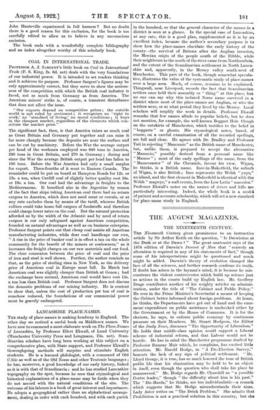COAL IN INTERNATIONAL TRADE. PROFESSOR A. J. Senomrr's little book
on Coal in International Trade (P. S. King, 2s. 6d. net) deals with the very foundations
of our industrial power. It is intended to set readers thinking and it achieves its purpose. Professor Sargent's figures may be only approximately correct, but they serve to show the serious- ness of the competition with which the British coal industry is faced, not so much from Germany as from America. The American miners' strike is, of course, a transient disturbance that does not affect the issue.
"Our exports depend on competitive prices ; the outside world is not ruled by sentiment ; it recognizes no 'right to work,' no 'standard of living,' no moral conditions ; it buys in the cheapest market, regardless of the elements which con- stitute the market price."
The significant fact, then, is that America raises as much coal as Great Britain and Germany put together and can raise it far more cheaply because the deposits are near the surface and can be cut by machinery. Before the War the average output per head of the workmen employed was 680 tons in America, 260 tons in Great Britain, and 270 in Germany ; during and since the War the average British output per head has fallen to 190 tons. Before the War America had only a small surplus for export. Three-fourths of it went to Eastern Canada. The remainder could be put on board at Hampton Roads for 12s. or 13s. a ton, when Cardiff coal of slightly better quality cost 18s. or 19s. a ton. Our coal had the advantage in freights to the Mediterranean. It benefited also in the Argentine by reason of the fact that ships taking American coal there had no return cargoes to America, which does not need meat or cereals, or at any rate excludes them by means of the tariff, whereas British colliers could take home full cargoes of foodstuffs and therefore could charge lower rates on the coal. But the natural protection afforded us by the width of the Atlantic and by need of return cargoes is our only safeguard against American competition, founded on natural advantages as well as on business enterprise. Professor Sargent points out that cheap coal assists all American manufacturing industries, while dear coal handicaps our own, "A rise in the price of bunker coal is in effect a tax on the whole community for the benefit of the miners or coalowners," as it increases the freight charges on our raw materials and our food. The close connexion between the price of coal and the price of iron and steel is well shown. Further, the author reminds us that, as the price of sterling rises in New York, so the delivery price of American coal in Europe must fall. In March last American coal was slightly cheaper than British at Genoa ; had the exchange been normal, American coal would have cost 15s. a ton less than British coal. Professor Sargent does not discuss the domestic problems of our mining industry. He is content to show that, unless the cost of Froduction per ton of coal is somehow reduced, the foundations of our commercial power must be gravely endangered.


































 Previous page
Previous page